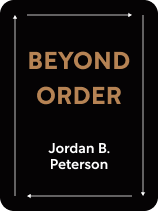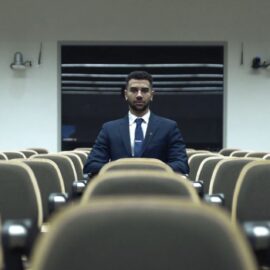

This article is an excerpt from the Shortform book guide to "Beyond Order" by Jordan Peterson. Shortform has the world's best summaries and analyses of books you should be reading.
Like this article? Sign up for a free trial here.
What’s your full potential? Is there a path to reaching it, or is it just pie in the sky?
Jordan Peterson believes that potential knows no bounds. In his book Beyond Order: 12 More Rules for Life, he challenges you to imagine who you could be, and then aim single-mindedly at that.
Read more to learn about Beyond Order Rule 2 and how it can open you up to a world of possibility.
Beyond Order Rule 2: Imagine Who You Could Be …
In choosing to take responsibility, stay committed, and work through your painful past, you’ll still need to know what direction is most worth heading in. With Beyond Order Rule 2, Peterson urges you to imagine who you could be, and then aim single-mindedly at that. He addresses how to determine what’s worth doing and how to become everything you can. Further, he asserts that because our world is full of suffering, we’re each obligated to become the best people that we can be. By doing so, we can help reduce suffering and bring some light to the world.
(Shortform note: In this rule, Peterson’s reasoning is utilitarian in character. Put roughly, utilitarianism is an ethical stance that holds that the right choice in a given situation is the one that results in the greatest good for everyone involved. In other words, utilitarian thinkers are often concerned with reducing pain or suffering while increasing pleasure or benefits. This kind of thinking works well in situations where the variables are easily quantifiable, like economic decisions, but breaks down with more qualitative considerations—for instance, it’s difficult to assign concrete values to art, time, or basic freedoms.)
Becoming all that you can be is possible because, according to Peterson, we live in a reality of boundless potential—the raw material of existence from which we can shape our lives. But, given this boundless potential, how can we possibly know how to act? Peterson suggests looking to the great stories of the past and imitating the heroes of our myths.
Today, we’ve inherited the great stories that cultures have developed and passed down since the ancient past. Peterson says that humanity has distilled the essential patterns of right or effective conduct into our myths and narratives—that is, the ways in which mythological characters act demonstrate the archetypes of conduct that we view as “right” and “wrong.” Think of the “hero” versus the “villain”—you can pick each out from a story based on how they behave.
(Shortform note: Note that Peterson’s perspective here is explicitly Western—that is, it’s based on Western myths and moral views, and Peterson references the Bible. However, other cultures may have different perspectives on the right way to be. For example, Confucianism, a 2,500-year-old Chinese moral philosophy, emphasizes moral virtues such as respect, humility, and loyalty to the family, which contrasts somewhat with the individual hero so prominent in Western culture.)
Primarily, Peterson recommends that you learn from the hero’s journey. This is the archetypal journey of the “chosen one” who is called away from home to face a great challenge, overcome the darkness within and without him or herself, and return victorious. For instance, think of the prince who leaves home to slay the dragon and rescue the maiden, or the Jedi who overcomes darkness to save the galaxy.
Peterson contends that the myth of the hero’s journey derives from early acts of human courage. Ancient hunter-gatherers had to leave the safety of the tribe and fire, go out into the night, overcome unknown dangers, and return with valuable resources such as food and water. This basic act of courage was necessary for our survival.
(Shortform note: Beyond just the hero’s journey, myths permeate our history and our lives. In Maps of Meaning, Peterson details the broader nature of myths and the roles they play in human life. Chiefly, he argues that mythological thinking helps us make subjective sense of the world and our place in it, whereas scientific thinking helps us determine objective knowledge. We tell stories about the objects around us—a three-foot-long stick fitted with a taut string is a bow, a smaller stick with a sharpened stone head is an arrow—and these stories lend those objects meaning. Abstract the many stories historical humans have told about the world around us—the tapestry of meaning we’ve looked to make from our experiences—and you get myth.)
Given this, Peterson recommends that you imitate these acts of courage. Draw inspiration from our ancestors, take heart, and face up to the darkness in your life. Today, our challenges are more abstract than giant snakes—still, we need to confront, overcome them, and grow stronger through those encounters. Peterson contends that in doing so, you’ll transform yourself into a modern-day hero, becoming wiser, more mature, and more competent.
To find the proper heroic motivation, Peterson suggests the following tactics:
- Pursue a noble and challenging goal—something lofty enough to spark courage within you.
- Embrace the inevitability of failure—you’ll almost certainly fail, so get ready to experience and overcome that pain when it comes.
- Be willing to fundamentally transform yourself—accept that shallow changes to your life may not be enough, and dig deep to change how you think, feel, and face the world.
(Shortform note: While Peterson’s framing is very heroic, the sort of courage he speaks to is very ordinary: It means having the integrity and accountability to face up to your life’s everyday challenges. This could be as mundane as building a new habit, becoming more reliable at work, or improving relationships with your friends and family. What Peterson stresses so heavily is that we must take these everyday challenges very seriously, knowing that our lives in fact hinge on the daily decisions we make about how accountable, sincere, and committed we want to be.)

———End of Preview———
Like what you just read? Read the rest of the world's best book summary and analysis of Jordan Peterson's "Beyond Order" at Shortform.
Here's what you'll find in our full Beyond Order summary:
- A no-nonsense guide to navigating the chaos of our difficult world
- How and why you should listen to your conscience
- How to show up for life as fully as you can






